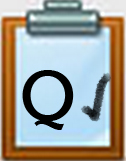Q2 Collaboration: What's It About?
IDENTIFY THE TOPIC
Your team will continue to work on the Planning Document to:
- Brainstorm some topic ideas.
- Decide the purpose of your presentation (informative or persuasive).
- Identify your intended audience.
- Select the final topic.
Brainstorm with a Graphic Organizer
Some Rules to Brainstorm with a Graphic Organizer. This resource is from 2.Quest 1.
Some digital graphic organizer tool suggestions:
- Graphic Organizers or play a Mind Map - Google Slides YouTube (4:32 min.)
- How to Make a Mindmap on PowerPoint YouTube (60-second YouTube video)
- Canva Graphic Organizers Maker
- You may have other digital tools that your teacher suggests or already knows about.
Some Characteristics of an Informative Presentation
- Should include factual information
- May consist of definitions, explanations, descriptions, images, and events
- Do not try to persuade an audience, give opinions, or take a position.
Some Characteristics of a Persuasive Presentation
- It opens with a strong introduction that grabs the audience's attention.
- Begins with a fact or an image that may be funny, emotional, or shocking about your topic.
- Identifies the problem and concludes with some solutions.
- Connects with the audience.
Competencies & Standards
MITECS Michigan Integrated Technology Competencies for Students, and
1. Empowered Learner
a. Articulate and set personal learning goals, developing strategies leveraging technology to achieve them, and reflect on the learning process itself to improve learning outcomes
b. Build networks and customize their learning environments in ways that support the learning process
c. Use technology to seek feedback that informs and improves their practice and to demonstrate their learning in a variety of ways
d. Understand the fundamental concepts of technology operations, demonstrate the ability to choose, use and troubleshoot current technologies and are able to transfer their knowledge to explore emerging technologies
6. Creative Communicator
a. Choose the appropriate platforms and tools for meeting the desired objectives of their creation or communication
c. Communicate complex ideas clearly and effectively by creating or using a variety of digital objects such as visualizations, models or simulations
d. Publish or present content that customizes the message and medium for a variety of audiences
7. Global Collaborator
b. With guidance from an educator, students use technology tools to work with friends and with people outside their neighborhood, city and beyond
c. Contribute constructively to project teams, assuming various roles and responsibilities to work effectively toward a common goal
Websites and Documents
Websites
- 10 Powerful Examples of How to End a Presentation
- 200+ Creative Hook Examples: Ready, Set, Hook
- Canva Graphic Organizers
- Graphic Organizers
21t4s Websites
- 7.Q1 Copyright Laws
- 9.Q1 Michigan eLibrary Advanced Search
- 9.Q4 Citing Your Source Tools
- Thing 7 Be Legal & Fair
Videos from Outside Sources
- A Beginner's Guide to Creating Presentations with Canva YouTube (4:27)
- Group Work Social Skills YouTube (5:18)
- How to End Presentation YouTube (2:27)
- How to Make a Mindmap on PowerPoint YouTube (0:60)
- How to Use PowerPoint: A Beginner's Step-by-Step Tutorial YouTube (37:58)
- Leadership and Effective Collaboration YouTube (3:22)
- Mind Maps Using Google Slides YouTube (4:32)
- Qualities that Make A Great Team Member YouTube (1:09)
- Setting Goals YouTube (4:13)
21t4s Videos
- 11. Powerful Presentation Q2. Collaboration Video (3:04)
- 11.Q1 Google Basic Slide Skills Tutorial Video (11:28)
21t4s Documents & Quizzes




